Fiberglass for painting: pros and cons
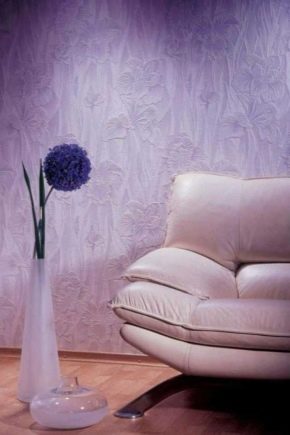
When carrying out finishing work, great importance is attached to each material involved in the finishing. Modern trends dictate their own rules, which extends to the high level of cladding. Let's pay attention to the fiberglass for painting: today this material is in great demand among professional craftsmen. Let's consider its features, pros and cons, methods of work and recommendations of specialists.
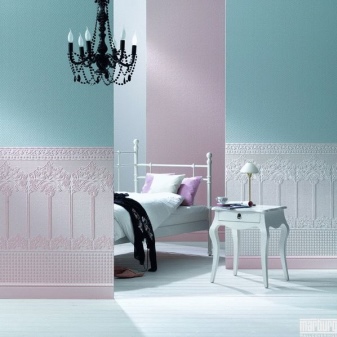
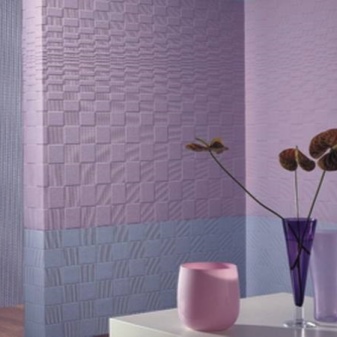
Peculiarities
Fiberglass is nothing more than a new generation of building material, which prepares the base surface for finishing. This is not fiberglass, as those who are unfamiliar with this material mistakenly believe. This raw material is in the form of a spider web, which is sold in rolls with a length of 50 m at a meter width. It appeared on the construction market relatively recently. However, the quality of the material allows what was previously difficult to do when finishing.
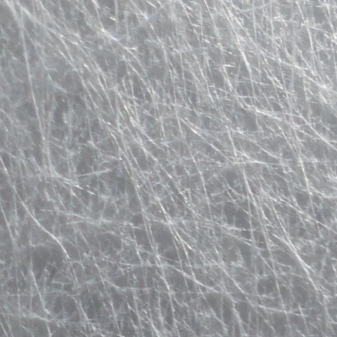
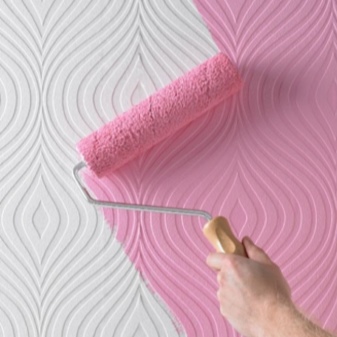
The fiberglass texture is a non-woven material. It consists of the finest fiberglass filaments that can be pressed. Externally, the fiberglass is thin and transparent. On a roll, the color of the spider web appears to be white. When viewed, these are cobweb threads, interconnected in a chaotic manner using an adhesive based on organic resins.
The raw material for the production of fiberglass is quartz sand. The density of the preparatory material for painting can vary from 25 to 50 g / m2. It matters when choosing raw materials for different planes. Typically, lower density varieties are used for vertical surfaces. For the walls, the one that is denser is needed. With an increase in density, the mass of the fiberglass becomes larger.
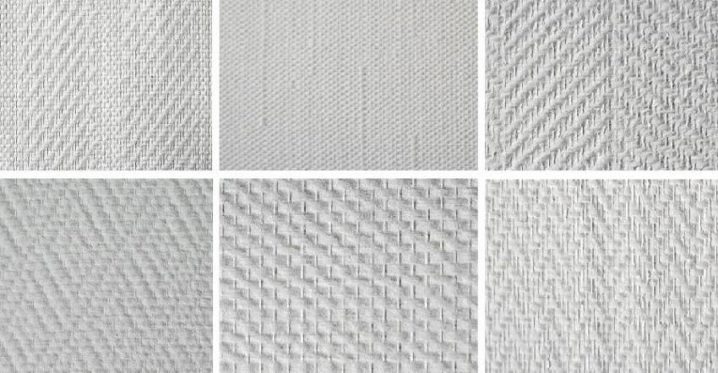
Scope of application
The scope of this material is extensive. Its use allows you to get rid of visual irregularities and obvious defects in the base without global preparatory work. Its function is reinforcement. This is a non-decorative material: after it is fixed on the base, it is putty, and then the surface is painted or pasted over with wallpaper.
Fiberglass for painting is used on different bases (from concrete to plastered and plasterboard). Due to its high qualities and performance characteristics, it can be used in rooms of different purposes. The type of premises can be residential or auxiliary. Often, such material is used in the preparation of the base of bedrooms, living rooms, offices, home libraries, bathrooms, hallways, corridors.
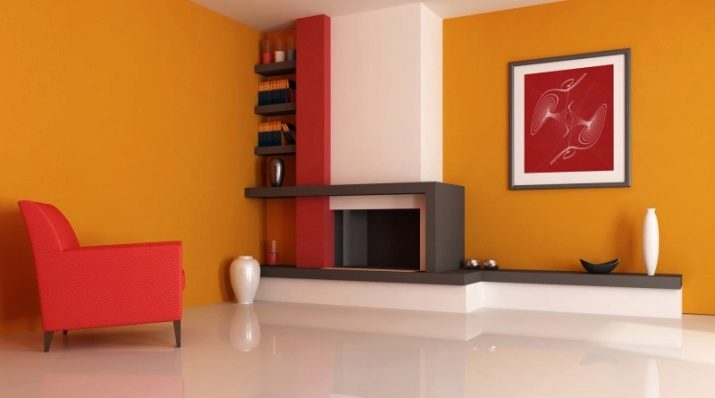

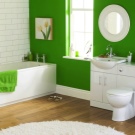

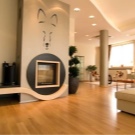
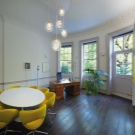
The popularity of fiberglass for painting is due to the prevention of cracks. A plane finished with paint after being reinforced with a cobweb will retain its attractive appearance for many years. You don't have to mask the cracks by touching them up with fresh paint.
In addition, paintable fiberglass can be used in the construction industry for:
- increasing the service life of metal pipes;
- manufacturing of floor cladding and wall panels;
- waterproofing structures;
- execution of drainage devices;
- preparation of mastics used to create the roof.

Advantages and disadvantages
Like any building material, fiberglass has advantages and disadvantages.
Let's note the advantages.
- It is resistant to temperature changes. You can prepare the plane for painting at a mode from -40 to +60 degrees. This will not affect the quality of the foundation preparation.
- Fiberglass is breathable and hygienic.Its use eliminates the formation of condensation and a medium for the appearance of fungus, as well as mold.
- The material is not electrified, as it is antistatic. For this reason, it does not accumulate dust.
- The use of the material does not have a negative impact on the health of the household. This is due to the environmental friendliness of the fiberglass.
- It is hypoallergenic. This nuance is especially important for allergy sufferers.
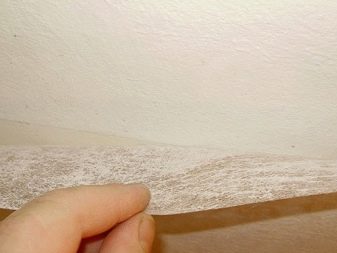

- Refractoriness is one of the most significant advantages. Such material is appreciated by every experienced craftsman.
- The price of fiberglass is available to every buyer, which makes it possible to make repairs inexpensive and of high quality. You can buy it at hardware stores.
- The fiberglass is highly wear-resistant. It doesn't deteriorate over time, so you don't have to repair it often.
- This material can be dyed. Its uniqueness is the fact that painting can be repeated.
Having studied the positive characteristics, we note the disadvantages, because they are not so harmless.
It is necessary to work with fiberglass with extreme caution. This is due to the fact that in the process of leveling the base, small glass fragments can break off from the canvas. Digging into the skin, they can cause significant harm to health, getting on the skin of the hands, body, sometimes in the eyes and respiratory system. In some cases, itching is possible; if it gets into the eyes, you will have to consult a doctor.
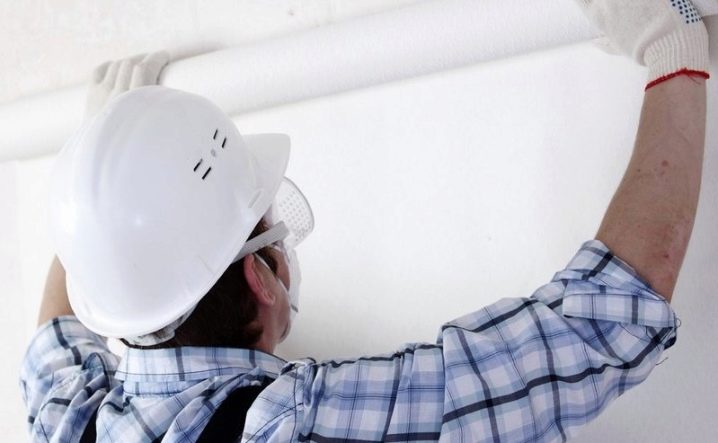
Working with fiberglass requires the obligatory use of closed clothing. You need to put on gloves on your hands, on your face - a respirator and goggles.
How to stick?
Consider the intricacies of using fiberglass for painting. This will allow you to get better acquainted with the material and understand the features of its application. Initially, we create optimal working conditions. It is better to carry out them at temperatures from +18 to +25 degrees. Windows should be closed during preparatory work. Drafts are excluded, you need to make sure that the fiberglass does not lie under the sun.
There is a small instruction to follow.
- Examine the surface of the base. If it has significant defects (potholes, large chips), set aside the fiberglass. In this case, you first need to get rid of visible imperfections with a putty or plaster mixture.
- After that, it is necessary to treat the base with a special primer. It is advisable to use a high penetrating primer. It will even out the surface structure, bind dust, and fill microcracks.
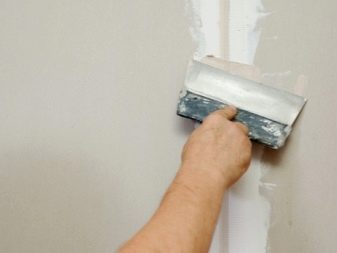
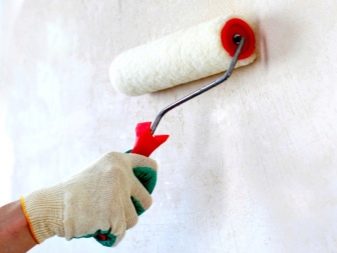
- After applying the primer, let it dry. During the drying process of the material, a fine crystal lattice is formed on the surface, which contributes to high adhesion. If you do not wait until the end of drying, the crate film will be broken.
- Fiberglass is not fixed with a whole piece of cloth. It must be cut into strips of such a size that it is convenient for you to work. At the same time, add small allowances to the edges (1 - 2 cm is enough).
- Prepare the fiberglass glue. Apply it to the back side along the sides and width. Spread the adhesive evenly in a thin layer (max. 1 mm).
- Start from the corner of the plane. It can be a ceiling or a wall. After gluing the first strip, the second is attached next to it, and so on all the others. In this case, a small overlap is formed, which must be trimmed after final fixation.
- So that the joints of the fiberglass strips do not diverge, it is necessary to additionally impregnate them with glue, pressing them especially carefully with a spatula. Experts emphasize the importance of this stage.
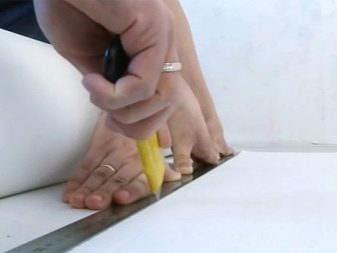
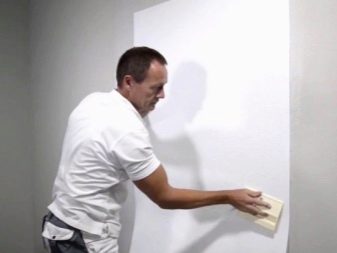
Now let the base dry for 2 days. Then putty it, then touch up with sandpaper to make it smooth. Re-prime the surface before painting and allow to dry.
How to paint?
After the surface is prepared, you can start painting. So that it does not cause trouble, it is important to choose the right coloring composition, the types of which there are many today.
You can choose paint:
- water-based;
- acrylic;
- silicone;
- latex.
A distinctive feature of such painting is the need to apply several layers. You cannot apply two layers at once: it will shrink or peel off in layers in a fairly short time, exposing the bases with putty. Failure to comply with the technology of using dye compositions is fraught with a reduction in the life of the paint. At the same time, it is unlikely that you will be able to paint such a surface several times.
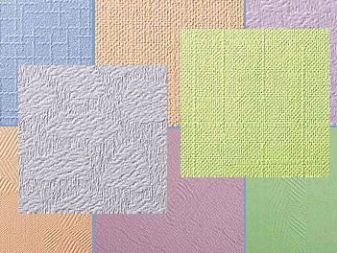
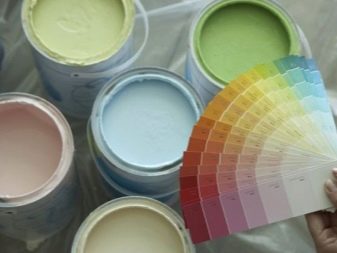
It is important to choose the right tool for the paint application to be of high quality. The brush in this case is only suitable for painting joints and corners. Using a roller will be more appropriate. It will speed up the time for painting, allow you to put a thin layer, which will reduce the consumption of the dye composition.
Dip the roller into a container of paint, squeeze it out a little and roll it flat. Do not use a tool with a foam rubber coat: the foam rubber will crumble into pieces. An analogue with a pile is needed. Movements should be in different directions: this will allow the paint to lie better and smoother. Do not forget that surfaces must be putty and primed before painting. When painting, you can apply two or three coats of the composition.
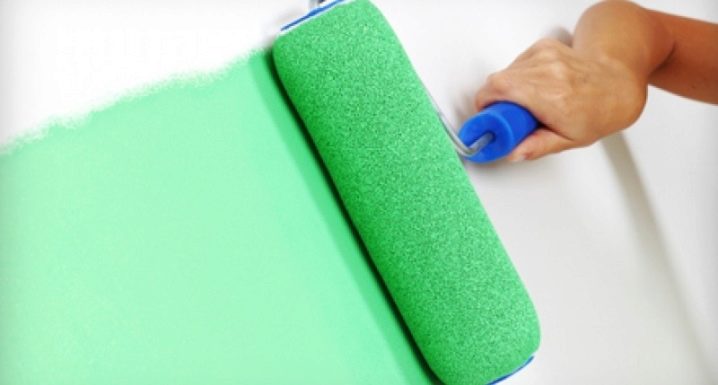
Advice
In order to prepare the surface for painting with fiberglass to be of high quality, refer to the recommendations of professionals in the field of construction and decoration.
- After you have glued the spider web to the surface, strengthen its fixation. To do this, dilute the glue to a liquid consistency and spread on top. It must saturate the fiberglass.
- Do not ignore the start-up work if it is really necessary. If you do not have enough experience, you can invite a specialist to help prepare the foundation.
- Do the job efficiently and without haste. The strength and reliability of the entire base will depend on how firmly you glue the fiberglass.
- As an adhesive, you can use the glue with which glass fiber is glued. The composition of such mixtures contains special inclusions that prevent the formation of fungus. If in doubt about the choice, ask the seller: not every wallpaper glue is appropriate here.
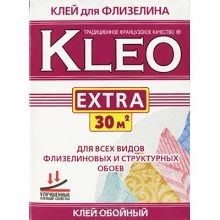

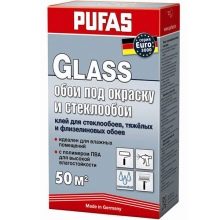
- When choosing dry glue, dilute it correctly. Pay attention to the harmless compounds Bostik, Wellton, Oscar, Pufas: they have positive reviews from buyers and construction professionals.
- If you need a glossy type of surface, buy latex paint.
Reviews
Fiberglass, according to reviews, is called a modern material for modern people who care about their health. Due to it, the walls look better, aesthetically more attractive, - note the comments left on the construction forums. They strengthen the plaster.
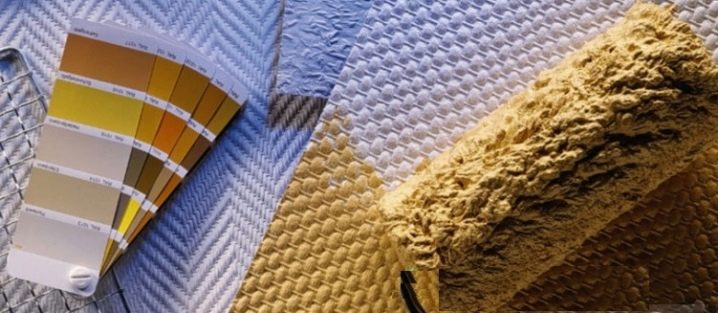
Those who have chosen paint for decorating surfaces write: for a perfect finish it is important to use a roller with a medium pile length. In this case, it is necessary to abundantly wet the tool in paint, soaking each section of the processed plane with it.
Beautiful examples
In conclusion, let us turn to examples of finishing works performed using glass fiber. They clearly show the possibilities of decorating different interior rooms.
- Painted walls look stylish. The transition of shades brings novelty and freshness to the interior.
- The use of wallpaper after surface reinforcement allows you to convey the uniqueness of the texture. The wall is perfectly aligned.
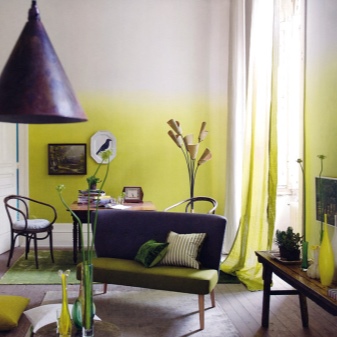
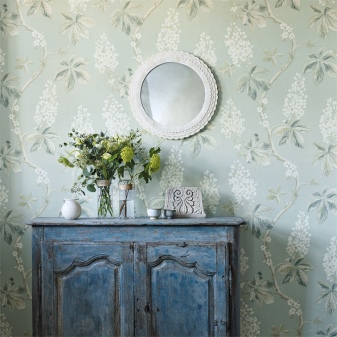
- Thin wallpaper is glued to the finished surface flawlessly. Due to the additional layer of putty, the base is flat.
- Decorating the surface with acrylic paints allows you to add abstract touches to the interior design.
- The wall decoration possibilities are endless. If your artistic skills allow, you can perform artistic painting over the fiberglass and putty. No type of wallpaper can compare with such a decoration for a child's room.
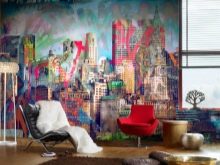
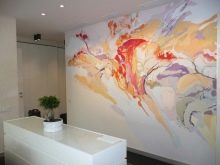
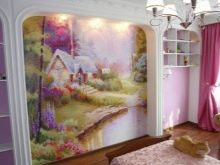
- The theme of glamor in the form of a stylized drawing is also appropriate. The desired mood of the interior is conveyed by means of acrylic paint.
- Stylish and cheerful solution to accentuate the dining area. The use of acrylic paint brings a charge of optimism to the interior.
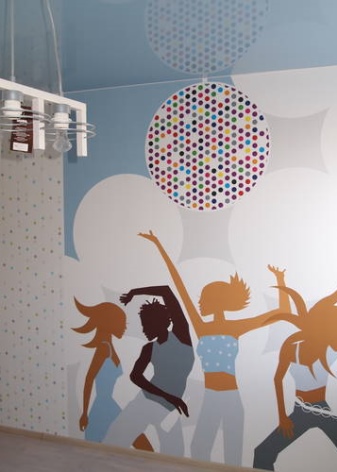
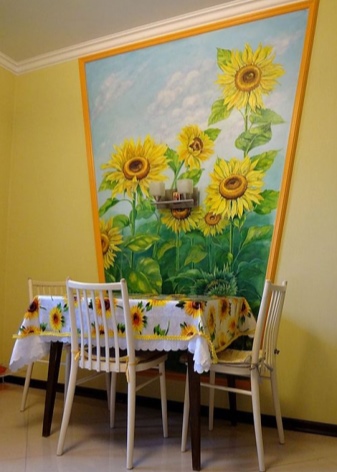
For information on how to glue the fiberglass on your own for painting, see the next video.













The comment was sent successfully.